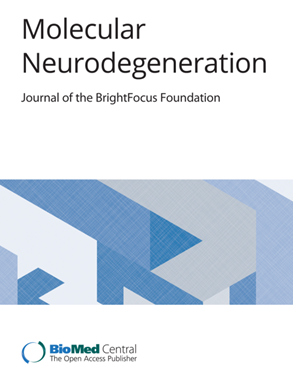From mechanisms to future therapy: a synopsis of isolated REM sleep behavior disorder as early synuclein-related disease
IF 17.5
1区 医学
Q1 NEUROSCIENCES
引用次数: 0
Abstract
Parkinson disease (PD), dementia with Lewy bodies (DLB) and multiple system atrophy are synucleinopathies, characterized by neuronal loss, gliosis and the abnormal deposition of α-synuclein in vulnerable areas of the nervous system. Neurodegeneration begins however several years before clinical onset of motor, cognitive or autonomic symptoms. The isolated form of REM sleep behavior disorder (RBD), a parasomnia with dream enactment behaviors and excessive muscle activity during REM sleep, is an early stage synucleinopathy. The neurophysiological hallmark of RBD is REM sleep without atonia (RWSA), i.e. the loss of physiological muscle atonia during REM sleep. RBD pathophysiology is not fully clarified yet, but clinical and basic science suggest that ɑ-syn pathology begins in the lower brainstem where REM atonia circuits are located, including the sublaterodorsal tegmental/subcoeruleus nucleus and the ventral medulla, then propagates rostrally to brain regions such as the substantia nigra, limbic system, cortex. Genetically, there is only a partial overlap between RBD, PD and DLB, and individuals with iRBD may represent a specific subpopulation. A genome-wide association study identified five loci, which all seem to revolve around the GBA1 pathway. iRBD patients often show subtle motor, cognitive, autonomic and/or sensory signs, neuroimaging alterations as well as biofluid and tissue markers of neurodegeneration (in particular pathologic α-synuclein aggregates), which can be useful for risk stratification. Patients with iRBD represent thus the ideal population for neuroprotective/neuromodulating trials. This review provides insights into these aspects, highlighting and substantiating the central role of iRBD in treatment development strategies for synucleinopathies.从机制到未来治疗:孤立的快速眼动睡眠行为障碍作为早期突触核蛋白相关疾病的概述
帕金森病(PD)、路易体痴呆(DLB)和多系统萎缩均为突触核蛋白病,以神经系统易损区神经元丢失、胶质增生和α-突触核蛋白异常沉积为特征。然而,神经退行性变在运动、认知或自主神经症状临床发作前几年就开始了。孤立的快速眼动睡眠行为障碍(RBD)是一种早期的突触核蛋白病,是一种在快速眼动睡眠中伴有梦境行为和过度肌肉活动的睡眠异常。RBD的神经生理学标志是快速眼动睡眠无张力(RWSA),即在快速眼动睡眠期间失去生理性肌肉张力。RBD的病理生理尚不完全清楚,但临床和基础科学表明,[-syn]病理始于快速眼动弛缓回路所在的脑干下部,包括嗅觉下被盖核/蓝下核和髓质腹侧,然后向下传播到大脑区域,如黑质、边缘系统、皮层。从遗传学上讲,RBD、PD和DLB之间只有部分重叠,患有iRBD的个体可能代表一个特定的亚群。一项全基因组关联研究确定了5个位点,它们似乎都围绕着GBA1通路。iRBD患者通常表现出细微的运动、认知、自主和/或感觉体征,神经影像学改变以及神经退行性变的生物流体和组织标志物(特别是病理性α-突触核蛋白聚集物),这可用于风险分层。因此,iRBD患者代表了神经保护/神经调节试验的理想人群。这篇综述提供了这些方面的见解,强调并证实了iRBD在突触核蛋白病治疗发展策略中的核心作用。
本文章由计算机程序翻译,如有差异,请以英文原文为准。
求助全文
约1分钟内获得全文
求助全文
来源期刊

Molecular Neurodegeneration
医学-神经科学
CiteScore
23.00
自引率
4.60%
发文量
78
审稿时长
6-12 weeks
期刊介绍:
Molecular Neurodegeneration, an open-access, peer-reviewed journal, comprehensively covers neurodegeneration research at the molecular and cellular levels.
Neurodegenerative diseases, such as Alzheimer's, Parkinson's, Huntington's, and prion diseases, fall under its purview. These disorders, often linked to advanced aging and characterized by varying degrees of dementia, pose a significant public health concern with the growing aging population. Recent strides in understanding the molecular and cellular mechanisms of these neurodegenerative disorders offer valuable insights into their pathogenesis.
 求助内容:
求助内容: 应助结果提醒方式:
应助结果提醒方式:


